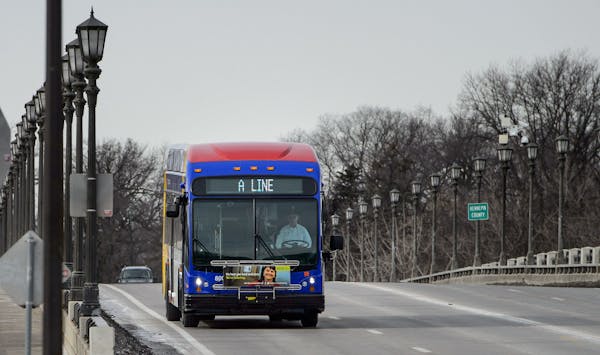Metro Transit ran a three-day pilot last spring to see if lanes dedicated exclusively to buses would speed up rush-hour trips along traffic-clogged Hennepin Avenue in south Minneapolis.
Riders have said speed, reliability and travel times are among their top concerns, and they gave the prospect of faster trips on one of the region's slowest corridors a big thumbs-up.
But their hopes were dashed last week when the agency said it will not put in the special lanes. At least not right away.
"The door is open for the possibility for bus lanes as the city redesigns Hennepin Avenue in 2022," said Metro Transit Senior Planner Michael Mechtenberg at last week's Metropolitan Council Transportation Committee meeting, where he gave an update on the agency's Speed and Reliability Initiative.
He gave no specific reason for the decision, but last fall spokesman Drew Kerr told the Drive that the 10-foot bus lanes used during the test were too narrow, and three days of testing just before Memorial Day might not have yielded a large enough sample to see how buses might perform on days with more traffic.
More than 400 buses run along the corridor between Franklin Avenue and the Uptown Transit Station near Lake Street.
With buses in traffic moving at a snail's pace and stopping to pick up and discharge the more than 3,300 daily riders, one disappointed rider hoping for anything that would shorten the trip took to Twitter, calling the decision "shameful."
The decision does not affect plans to bring rapid bus service to Hennepin Avenue. Metro Transit is moving forward with plans this year to replace part of Route 6 with the service that stops at stations spaced about every quarter- to half-mile.
While plans for bus-only lanes on Hennepin are on hold, Metro Transit is looking to make changes to speed up other routes, much like it did last fall on Route 2.
After consolidating stops and adding bus shelters on the route that snakes its way from the University of Minnesota area to south Minneapolis along Franklin Avenue, trip times were 6 percent faster. Things might get even more speedy in 2019 as the agency looks to bring Transit Signal Priority (TSP) to the route. TSP allows computers on buses to communicate with stoplights to request longer green lights or shorter red lights.
Metro Transit is looking to do similar things on Route 63, which serves downtown St. Paul, Grand Avenue and the Sun Ray Transit Center and connects to the Green Line light rail.
The route, which has 4,500 daily weekday boardings, was chosen for study this year because it is similar to Route 2 and could benefit from consolidating stops and adding TSP, Mechtenberg said. Metro Transit plans to hold outreach meetings this spring and fall to gather public input.
Taz tangles traffic
Leave it to a runaway pooch named Taz to bring traffic to a halt.
Troopers shut down the lanes of I-94 near the Lowry Avenue overpass about 2 a.m. Friday after the little dog was spotted in danger.
Troopers moved in and, after about 30 minutes, coaxed the dog into a squad and took it to the Minneapolis Animal Care and Control Center.
It all comes with the job of protecting and serving.
"The State Patrol responds to animals on freeways as part of our job duties," said Lt. Gordon Shank.
Follow news about traffic and commuting at The Drive on startribune.com. Got traffic or transportation questions, or story ideas? E-mail drive@startribune.com, tweet @stribdrive or call Tim Harlow at 612-673-7768.

Jill Biden travels to Minnesota to campaign for Biden-Harris ticket
Want to celebrate 4/20? Here are 33 weed-themed events across Minnesota.

Legendary record store site in Minneapolis will soon house a new shop for musicheads

Former Gov. Jesse Ventura boasts he could beat unpopular Trump or Biden if he ran for president

